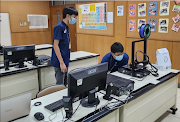UP NISMED hosted an intensive seven-day STEM Immersion Program from 19 to 27 June 2023 for three students from Philippine Science High School (PSHS) - Central Mindanao and Southern Mindanao campuses and Ateneo de Davao University. The program provided specialized training in various STEM fields, including 3D printing, block-based coding, and space science technology.
The first part of the immersion program focused on 3D Printing and was supervised by Mr. Jobeth G. Martecio from the Information Science Group. During this part of the immersion program, the student interns learned to build 3D models using the online modeling program Tinkercad and operate Fused Deposition Modeling (FDM) printers to create physical copies of their designs. They successfully designed and printed 3D manipulatives related to science and mathematics topics such as fault systems and number sets. Additionally, they developed an instruction manual on operating an FDM model. The second part of the immersion program, centered on coding using the MIT App Inventor, a web-based visual programming platform that makes use of block-based coding. Under the guidance of Mr. John Alex M. Reyroso from the Information Science group, the student-interns learned how to use the built-in components and features of the MIT App Inventor to create various mobile applications. They developed a Talking app using the Text to Speech component, designed a Date Calculator app for calculating days between dates, and built a Registration Form app for verifying user input.
 |
| Student-interns print physical copies of their 3D model designs using the Fused Design modeling printers. |
In the final phase of the immersion program, the student-interns received training on space science technology applications. Facilitated by Mr. Anthony Guiller Urbano from the High School Earth Science Group and Dr. Mark Angelo Purio from Adamson University’s Space Technology and Research Laboratories (STARLab), the student-interns learned about satellite-based communication. They constructed their own satellites using affordable materials such as copper tubing and PVC pipes. With the aid of radio transceivers, they were able to successfully send and receive signals to and from satellites in orbit, as well as contact nearby and distant radio users. They also gained knowledge of Morse Code transmissions and discussed amateur radio licensing requirements.
 |
| STEM Immersion interns build an improvised satellite antenna using copper tubing and PVC pipe (left). Student interns use an amateur radio equipment to contact nearby and distant radio users (right). |
The STEM Immersion Program proved to be an invaluable experience for the student interns. During the closing program on June 27, attended by UP NISMED Director
Dr. Sheryl Lyn C. Monterola and Deputy Director for Research and Extension Dr. Monalisa T. Sasing, the students expressed gratitude for the opportunity to be part of this unique internship program. They shared some of their memorable moments and reflected on how the experience helped their personal growth. All of the student interns agreed that they gained valuable knowledge and skills that will undoubtedly benefit them in their future STEM endeavors.
 |
| UP NISMED Director Dr. Monterola hands over the certificate completion to the student interns. |
As the student interns return to their respective schools, they carry with them new knowledge and skills in 3D Printing, coding, and space science technologies. UP NISMED's STEM Immersion Program exemplifies the importance of experiential learning and the transformative power of technology in shaping the future generation of STEM professionals.





0 Comments